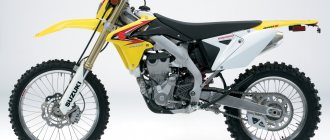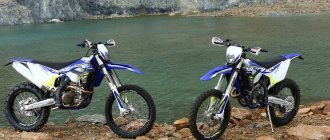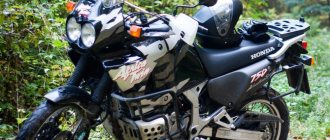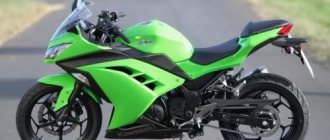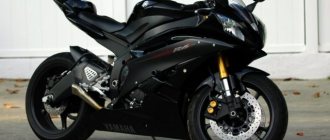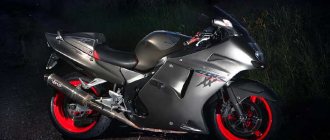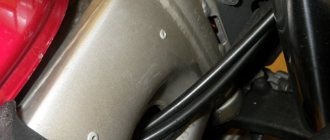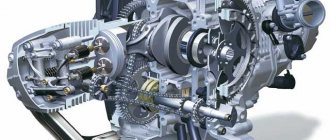Yamaha WR250 is an Enduro motorcycle that was introduced to customers in 2001. This is an excellent sports model, created on the basis of the YZ250F motorcycle of the same manufacturer. The technical characteristics and features of the bike are truly impressive. These are adjustable suspensions, high speed, excellent maneuverability on any track. This model differs from the previous version of the Yamaha bike with new, more efficient and convenient engine settings, excellent traction even at low speeds and larger radiators. Other characteristics are also important, for example, the WR250 motorcycle with adjustable suspension has a side stand, and its exhaust is quieter and more environmentally friendly. There are several budget solutions Yamaha WR250 R and X, which can be an excellent replacement for the classic bike of the F modification. If the first model is a Hard Enduro version, then the next two are known as lightweight Enduro and supermoto with high-quality road wheels, clamped suspension and powerful brakes. On such a motorcycle you can enjoy every minute of the ride, get real pleasure, conquer new horizons, and travel long distances. Only a few modifications can compete with this popular bike and fully satisfy true fans of fast riding.
For whom
Here are the main features of the Yamaha TTR 250:
- maintainability;
- reliability;
- affordable price.
In addition, the motorcycle is sufficiently developed, and there will not be any glaring problems with it. Convenient and simple, the Yamaha TTR 250 will suit many connoisseurs of the class who need a good and inexpensive option with decent performance.
Driving performance
The driving performance of this cross-country monster is still relevant today, although it has been gone for almost twenty years since the model was introduced.
Per 100 km, the Yamaha YZ 250 F consumes from 5.5 to 6 liters of fuel . The difference depends on the wear of the chassis and the quality of gasoline.
Fuel consumption
In an effort to improve the model, the developers first increased the tank to 7.5 liters, which allowed it to travel more than 100 km, then reduced it to a minimum.
Users note that the volume to the neck is just over 6 liters .
Speed
The maximum speed of the model is only 165 km/h. Here I would like to dwell in more detail, most of the data speaks about exactly this parameter, but our friends were able to squeeze out of it no more than 130 km/h at stock settings.
But good suspension, increased fork travel, as well as the minimum weight of the model enable the motorcyclist to overcome the most difficult sections and (if desired) fly part of the way in a jump, which allows increasing performance.
A lightweight and nimble bike that is equally stable on the ground or when performing tricks, adding to the confidence of the rider.
Dimensions and weight
The length of the machine is 2100 mm, its height is 255 mm, and its width is 835 mm. The seat height of the TTR 250 is 895 mm and the wheelbase is 1415 mm. This is far from the most comfortable motorcycle for people under 180 cm tall. The weight of the bike including fuel is 124 kg. The 9.5L tank is fairly typical for enduro. Average fuel consumption per hundred kilometers ranges from 3 liters to 4 liters.
Which of the modern trio is better, Yamaha WR250R, Kawasaki KLX250S or Honda CRF250L?
If you look at the technical characteristics, then Yamaha simply destroys Kawasaki and Honda. True, until we talk about price. The new WR250R will cost you over 100 grand more than the KLX250S. At the end of 2019, dealers are asking about 400 thousand rubles for the Kawasaki KLX250S, and even less with discounts. But for the Yamaha WR250R, the price varies from 500 to 600 thousand rubles. In addition, it is more difficult to find on sale, since now it is not officially sold in Russia. Honda CRF250L, priced somewhere between its competitors.
Don't conclude that the Kawasaki KLX250S or Honda CRF250L are bad motorcycles compared to the Yamaha WR250R. Not at all. Each of these motorcycles is worth the money. Yamaha is more expensive, but also better and more technologically advanced.
But how do these motorcycles feel on the move? Kawasakis and Hondas give the impression of more soft devices and are probably better suited for beginner riders. Despite the fact that the engines are weaker than on the Yamaha, they pull better at the bottom, but the WR needs to be constantly revved. The suspension is noticeably inferior to the Yamaha, but on the other hand, the seat height is significantly lower, which is also a plus for beginners. The Yamaha is more powerful, has better suspension, and is generally better made than the Kawasaki, especially in details and is approximately on the same level as the Honda and is suitable for more experienced and demanding riders. I’ll also add that in practice, of course, there is a difference between these motorcycles, but it is not drastic.
Chassis and brakes
The frame of this product is made of steel. By type it is duplex. There is no chic in its appearance, but all elements are made carefully and tastefully. The steering wheel here is typical, as are the spoked wheels, which immediately makes it possible to recognize the TTR 250 as a purebred enduro.
The rear pendulum suspension here is equipped with a monoshock absorber, and the front one is a telescopic fork. The TTR 250 brakes at the rear using a 220 mm disc complete with a single-piston caliper, and at the front for this purpose a 245 mm disc is used together with a two-piston caliper.
Comparative technical characteristics of motorcycles Yamaha WR250R, Kawasaki KLX250S and Honda CRF250L
| Yamaha WR250R | Kawasaki KLX250S | Honda CRF250L | |
| Engines | 249 cm3, 1-cylinder, 4-stroke, liquid cooling; 4 valves | 249 cm3, 1-cylinder, 4-stroke, liquid cooling; 4 valves | 249.6 cm3, 1-cylinder, 4-stroke, liquid cooled; 4 valves |
| Power | 31.0 hp (23.0 kW) at 10000 rpm | 24.0 hp (18.0 kW) at 9000 rpm | 22.8 hp (17.0 kW) and 25.0 hp (18.2 kW) from 2021 at 8500 rpm |
| Torque | 24.0 Nm at 8000 rpm | 21.0 Nm at 7000 rpm | 22.0 Nm (22.6) at 6500 rpm |
| Fuel supply system | Injector | Injector | Injector |
| Transmission | 6-speed | 6-speed | 6-speed |
| Front suspension | 46mm inverted fork, fully adjustable. Stroke – 270 mm | 43mm inverted fork, adjustable. Stroke – 255 mm | 43 mm inverted fork, no adjustments. Stroke – 250 mm |
| Rear suspension | Pendulum with monoshock absorber, fully adjustable. Stroke – 270 mm | Pendulum with monoshock absorber, adjustable. Stroke – 230 mm | Pendulum with monoshock absorber, preload adjustment. Stroke – 240 mm |
| Front brakes | 250 mm floating disc, two-piston caliper | 250 mm disc, two-piston caliper | Disc 256 mm, two-piston caliper (possibly with ABS) |
| Rear brakes | Disc 230 mm. single piston caliper | Disc 240 mm. single piston caliper | Disc 220 mm. single-piston caliper (possibly with ABS) |
| Frame | Half duplex aluminum | Half duplex steel | Half duplex steel |
| Seat height | 930 mm | 890 mm | 875 mm |
| Curb weight | 134 kg | 136 kg | 143 kg (146 kg with ABS) |
| Fuel tank volume | 7.6 l. | 7.7 l. | 7.8 l. |
Author Evgeniy Naboka
If you suddenly decide to buy a motorcycle, we will be happy to help you choose the right one.
